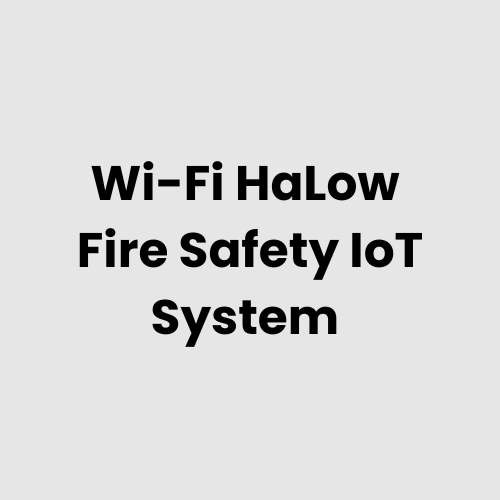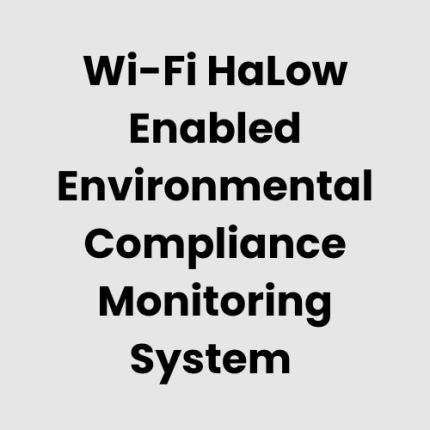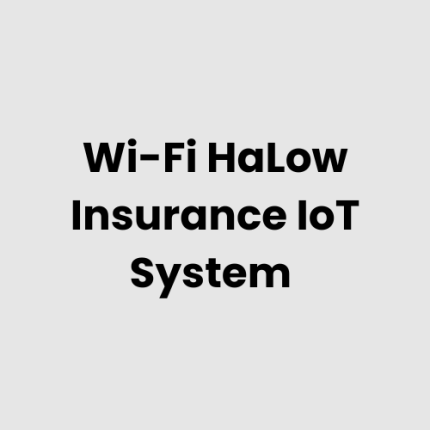Description
Wi-Fi HaLow Fire Safety IoT System: Technical Architecture
The Wi-Fi HaLow Fire Safety IoT System leverages advanced Internet of Things (IoT) technology to enhance fire safety monitoring and response capabilities in buildings, industrial sites, and other facilities. By utilizing Wi-Fi HaLow’s long-range and low-power features, the system provides continuous fire detection, emergency alerts, and real-time monitoring to help prevent disasters and save lives.
The technical architecture of the Wi-Fi HaLow Fire Safety IoT System is composed of several layers, working together to provide seamless fire detection and response:
- Connectivity Layer: The system operates on the Wi-Fi HaLow standard (IEEE 802.11ah), providing reliable, low-power, and long-range connectivity that is ideal for wide-area coverage within a building or campus. This enables communication between sensors, alarms, controllers, and a central monitoring system.
- IoT Devices Layer: The primary components of this layer include smoke detectors, heat sensors, flame detectors, gas leak sensors, and fire alarms. These devices are responsible for detecting fire hazards in various environments and transmitting data to the system for analysis and action.
- Edge Computing Layer: Edge computing devices are deployed to process sensor data locally, enabling rapid response times for immediate actions, such as triggering alarms or initiating fire suppression systems. These devices can filter and analyze data in real-time, reducing network traffic and enabling faster decision-making.
- Data Aggregation and Cloud Layer: Data from edge devices and sensors is sent to a central cloud platform, where it can be stored, analyzed, and processed for advanced features like predictive maintenance, trend analysis, and system optimization. This cloud layer provides scalability, redundancy, and centralized management for the entire system.
- Security Layer: Given the critical nature of fire safety, robust security measures, including encryption, authentication, and secure transmission protocols, are implemented to protect the system against cyber threats and unauthorized access. Secure communication ensures the integrity and safety of data from IoT devices.
Hardware Components of the Wi-Fi HaLow Fire Safety IoT System
The hardware components of the Wi-Fi HaLow Fire Safety IoT System are specifically designed to ensure reliable operation, real-time data transmission, and high-level security in hazardous environments:
- Wi-Fi HaLow Routers and Gateways: These components form the backbone of the communication network, providing long-range connectivity to all IoT devices within a building or facility. They support low-power devices and enable stable, secure transmission of critical data to edge devices or the cloud.
- IoT Sensors: This category includes various fire and gas detection sensors:
- Smoke Detectors: These detect smoke and alert the system when unusual levels of smoke are present.
- Heat Sensors: These detect rapid increases in temperature, signaling potential fire hazards.
- Flame Detectors: These sensors identify the presence of flames, providing early detection of fires.
- Edge Computing Devices: These devices process data from sensors in real time, making quick decisions about actions like triggering alarms or activating fire suppression systems. They ensure that critical data does not need to be sent over the network immediately, reducing bandwidth usage and latency.
- Local Servers: In environments where cloud-based solutions may not be viable or preferred, local servers store and process data on-site. This helps to maintain control over fire safety data, ensuring that operations can continue even if connectivity to the cloud is disrupted.
- Fire Alarms and Suppression Control Systems: Devices that initiate actions based on sensor inputs, such as activating fire alarms, sirens, emergency lighting, or even fire suppression systems like sprinklers or foam dispensers.
- Monitoring and Management Consoles: These are the central units where the real-time status of the fire safety system is displayed and managed. They provide operators with alerts, reports, and control over the system’s responses to fire hazards.
Physical Placement Considerations of the Hardware
The successful implementation of the Wi-Fi HaLow Fire Safety IoT System relies on strategically placing devices to ensure comprehensive coverage and maximum efficiency:
- Wi-Fi HaLow Routers and Gateways: These should be distributed to ensure consistent and uninterrupted connectivity across the entire facility. Placement near key access points or within central locations allows for optimal signal strength and coverage, preventing blind spots in the network.
- IoT Sensors: Placement of fire detection sensors is crucial:
- Smoke and Heat Detectors: These should be installed in areas prone to fire risks, such as kitchens, electrical rooms, or mechanical areas, and should comply with local fire safety regulations.
- Flame and Gas Detectors: Flame detectors should be placed in areas with open flames or high-temperature equipment, while gas sensors should be installed near potential gas sources or machinery.
- Edge Devices: Edge computing devices should be strategically placed close to sensor clusters to minimize communication delays and to ensure that data is processed in real-time for swift action.
- Fire Alarms and Control Systems: These should be installed in common areas such as hallways, exit routes, and entryways to ensure that alarms are heard throughout the building. Control systems should be located in secure locations where they can be monitored continuously by safety personnel.
- Monitoring Consoles: These should be placed in fire control rooms or emergency response centers, allowing operators to receive real-time updates and manage responses to detected fire hazards.
Hardware Architecture of the Wi-Fi HaLow Fire Safety IoT System
The hardware architecture follows a hierarchical approach to ensure effective fire safety monitoring and control across multiple levels:
- Connectivity Backbone: Wi-Fi HaLow routers and gateways form the connectivity backbone, providing stable and secure communication for all IoT sensors, edge devices, and control systems.
- Sensor Layer: The sensors, including smoke, heat, flame, and gas detectors, act as the first line of defense against potential fire hazards. These devices are responsible for capturing environmental data and alerting the system to any anomalies.
- Edge Devices: Edge computing devices process sensor data in real-time, filtering out irrelevant information and ensuring that only actionable data is transmitted to the cloud or local servers.
- Local Servers or Cloud Platform: The data from edge devices is aggregated and processed centrally in either a cloud platform or local servers, depending on the system’s deployment strategy. Cloud platforms provide scalability, data redundancy, and advanced analytics capabilities, while local servers ensure uninterrupted operation even without cloud connectivity.
- Alarm and Control Layer: The fire alarms and suppression control systems form the final layer, responding to sensor inputs by activating alarms, notifications, or fire suppression systems. These devices ensure that emergency actions are taken promptly to minimize damage.
Deployment Considerations of the Wi-Fi HaLow Fire Safety IoT System
When deploying the Wi-Fi HaLow Fire Safety IoT System, there are several critical factors to consider to ensure effective operation and compliance:
- Network Coverage: Ensure that the Wi-Fi HaLow network has full coverage across the entire facility, including areas with potential fire hazards. Proper placement of routers and gateways ensures consistent communication across sensors and alarms.
- Compliance with Regulations: Adhere to local fire safety regulations and standards, such as National Fire Protection Association (NFPA) codes and local fire safety requirements. Sensors and devices must be placed and calibrated in accordance with these guidelines.
- System Redundancy: To ensure the reliability of the system, deploy redundant routers, edge devices, and servers where necessary. This helps avoid single points of failure and ensures uninterrupted fire safety monitoring.
- Integration with Existing Safety Systems: The IoT fire safety system should integrate with existing building management and fire safety systems, including HVAC, emergency lighting, and building automation systems, to coordinate responses in case of a fire emergency.
- Real-Time Monitoring: Implement a continuous monitoring system that provides real-time updates and alerts to security personnel, allowing them to take immediate action if a fire hazard is detected.
List of Relevant Industry Standards and Regulations
- National Fire Protection Association (NFPA) Codes
- International Fire Code (IFC)
- Underwriters Laboratories (UL) Standards
- Occupational Safety and Health Administration (OSHA) Regulations
- ISO/IEC 27001 (Information Security Management)
- ISO/IEC 20000-1 (IT Service Management)
- Fire Safety and Building Safety Regulations (varies by region)
- American National Standards Institute (ANSI) Standards
Local Server Version: Running with a Local Server
In cases where a cloud-based solution may not be feasible, the Wi-Fi HaLow Fire Safety IoT System can be deployed with local servers to ensure that critical data processing happens on-site:
- Real-Time Decision Making: Local servers enable the immediate processing of fire detection data, allowing the system to trigger alarms or suppress fires without needing to rely on external cloud services.
- Data Security: Data is stored and processed locally, enhancing security by reducing the risk of remote breaches and complying with strict data protection regulations.
- Reliable Operation: In environments where internet connectivity might be unreliable, a local server version ensures the system remains operational regardless of external factors.
Cloud Integration and Data Management
The cloud-based solution of the Wi-Fi HaLow Fire Safety IoT System provides several benefits:
- Data Aggregation and Storage: Data from IoT sensors and devices is sent to the cloud for centralized storage, providing redundancy and scalability for large facilities.
- Advanced Analytics: The cloud platform enables advanced data analytics, helping to predict fire risks, optimize sensor placement, and improve the overall fire safety strategy by analyzing historical data and patterns.
- Remote Monitoring: Through cloud integration, the fire safety system can be remotely monitored from any location, providing real-time alerts and status updates to safety personnel, even when they are off-site.
- System Integration: The cloud can integrate with other building management systems, creating a holistic approach to building safety, including HVAC, emergency lighting, and access control, ensuring a coordinated response in emergencies.
GAO Case Studies of Fire Safety IoT
USA Case Studies
- New York City, New York: Fire departments in New York City have utilized IoT sensors to monitor building temperature and smoke levels, enabling real-time alerts for potential fire hazards. GAO Tek provides advanced IoT solutions to enhance fire safety monitoring in urban environments. Learn more about fire safety IoT solutions.
- San Francisco, California: In San Francisco, IoT-enabled smoke detectors and heat sensors were installed in high-rise buildings to provide continuous monitoring and improve emergency response times. GAO Tek’s IoT technologies support proactive fire risk management. Discover IoT for smart fire safety.
- Chicago, Illinois: A Chicago-based property management company incorporated IoT sensors to monitor fire alarm systems across multiple facilities, ensuring faster response times. GAO Tek offers IoT tools to improve fire safety operations. Explore IoT for fire alarm monitoring.
- Miami, Florida: IoT sensors in Miami were used to track the condition of fire extinguishers and sprinkler systems in commercial buildings, enhancing compliance with safety regulations. GAO Tek offers IoT solutions for maintaining safety equipment. Learn about IoT for safety equipment monitoring.
- Dallas, Texas: A commercial complex in Dallas implemented IoT-enabled fire safety systems that automatically activated sprinklers when smoke levels exceeded preset thresholds. GAO Tek’s IoT solutions provide fast, automated responses to fire hazards. Explore IoT for automated fire response.
- Los Angeles, California: In Los Angeles, a high-tech building used IoT-connected smoke detectors and cameras to provide real-time monitoring and analysis, improving early detection of fires. GAO Tek provides fire safety IoT systems that enhance emergency preparedness. Discover IoT for early fire detection.
- Washington, D.C.: Fire safety authorities in Washington, D.C. used IoT devices to detect gas leaks and fire risks in high-risk industrial areas. GAO Tek delivers advanced IoT sensors to detect hazardous situations before they escalate. Explore IoT for gas leak detection.
- Boston, Massachusetts: A university in Boston incorporated IoT-based fire alarms and surveillance systems to ensure continuous fire safety monitoring in student dormitories. GAO Tek offers reliable IoT solutions for campus fire safety management. Learn more about fire safety IoT on campuses.
- Phoenix, Arizona: In Phoenix, IoT sensors were integrated into large retail stores to monitor fire safety systems, automatically notifying authorities when action was needed. GAO Tek’s IoT systems ensure the safety of large public spaces. Discover IoT for fire safety in retail.
- Seattle, Washington: IoT-based environmental sensors in Seattle were employed to assess the fire risks in forests and remote areas, allowing for early intervention during wildfire season. GAO Tek offers solutions that assist in fire detection and prevention in natural environments. Learn about IoT for wildfire prevention.
- Houston, Texas: Firefighters in Houston utilized IoT devices to track the location of hazardous materials and improve response times in emergency situations. GAO Tek provides IoT-based safety management tools for fire departments. Explore IoT for emergency response.
- Denver, Colorado: A Denver industrial site implemented IoT systems to monitor the status of fire suppression equipment, reducing downtime and ensuring reliability. GAO Tek offers solutions that support fire suppression system management. Discover IoT for fire suppression monitoring.
- Minneapolis, Minnesota: A hospital in Minneapolis adopted IoT fire safety systems that automatically notify security teams of fire risks, reducing human error in emergency situations. GAO Tek supports healthcare facilities with advanced fire safety monitoring. Learn more about fire safety in healthcare.
- Indianapolis, Indiana: A financial institution in Indianapolis integrated IoT-connected fire alarms and cameras to ensure fast, accurate fire risk assessments across their branches. GAO Tek provides IoT-based solutions to safeguard banking environments. Explore IoT for financial facility fire safety.
- Atlanta, Georgia: IoT devices were used in Atlanta to monitor and control fire risks in large warehouses, improving fire safety management by tracking temperature fluctuations. GAO Tek’s IoT systems enhance warehouse safety. Learn about IoT for warehouse fire safety.
Canada Case Studies
- Toronto, Ontario: Fire departments in Toronto adopted IoT-based smoke detectors and heat sensors in commercial areas, enabling quick fire detection and more efficient evacuation strategies. GAO Tek offers solutions for optimizing fire safety in urban spaces. Discover IoT for fire safety in urban areas.
- Vancouver, British Columbia: In Vancouver, IoT-connected systems were used to monitor building fire alarms and sprinkler systems, ensuring compliance with safety regulations. GAO Tek provides reliable fire safety IoT solutions for public and private buildings. Explore IoT for building fire safety.
Navigation Menu for Wi-Fi HaLow
- Wi-Fi HaLow Gateways/Routers
- Wi-Fi HaLow End Devices
- Wi-Fi Halow – Cloud, Server, PC & Mobile Systems
- Wi-Fi HaLow Accessories
Navigation Menu for IoT
- LORAWAN
- Wi-Fi HaLow
- Z-WAVE
- BLE & RFID
- NB-IOT
- CELLULAR IOT
- GPS IOT
- IOT SENSORS
- EDGE COMPUTING
- IOT SYSTEMS
Our products are in stock and can be shipped anywhere in the continental U.S. or Canada from our local warehouse. For any further information, please fill out this form or email us.
We are looking for partners. For more information on partnering with GAO, please visit Partner with GAO Tek Inc. It lists various ways to partner with GAO, such as OEM Partnerships, Technology Integration, Distribution and Reselling Opportunities, Presenting at the Leading Event TekSummit, Joint R&D Projects, Training and Consulting Services, Industry-Specific Collaborations, Research and Academic Partnerships.



